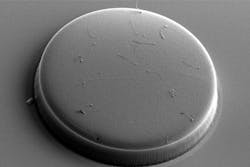Carbon nanotubes snag molecules in new device
A new technique can trap hard-to-detect molecules using forests of carbon nanotubes.
Engineers at MIT modified a simple microfluidic channel with an array of vertically aligned carbon nanotubes, which are rolled lattices of carbon atoms that resemble tiny tubes of chicken wire. The researchers had previously devised a method for standing carbon nanotubes on their ends like trees in a forest. With this method, they created a three-dimensional array of permeable carbon nanotubes within a microfluidic device through which fluid can flow.
Now, the nanotube array can to trap certain particles, as reported in a study published in the Journal of Microengineering and Nanotechnology. To do this, the team coated the array, layer by layer, with polymers of alternating electric charge.
"You can think of each nanotube in the forest as being concentrically coated with different layers of polymer," said Brian Wardle, professor of aeronautics and astronautics at MIT. "If you drew it in cross-section, it would be like rings on a tree."
Depending on the number of layers deposited, the researchers can create thicker or thinner nanotubes and tailor the porosity of the forest to capture larger or smaller particles of interest.
The nanotubes’ polymer coating may also be chemically manipulated to bind specific bioparticles flowing through the forest. To test this idea, the researchers applied an established technique to treat the surface of the nanotubes with antibodies that bind to prostate specific antigen (PSA), a common experimental target. The polymer-coated arrays captured 40 percent more antigens, compared with arrays lacking the polymer coating.
Wardle said the combination of carbon nanotubes and multilayer coatings may help finely tune microfluidic devices to capture extremely small and rare particles, such as certain viruses and proteins.
"There are smaller bioparticles that contain very rich amounts of information that we don’t currently have the ability to access in point-of-care [medical testing] devices like microfluidic chips," says Wardle, who is a co-author on the paper. "Carbon nanotube arrays could actually be a platform that could target that size of bioparticle."
According to Wardle, the nanotube array is extremely versatile, as the carbon nanotubes may be manipulated mechanically, electrically and optically, while the polymer coatings may be chemically altered to capture a wide range of particles. He says an immediate target may be biomarkers called exosomes, which are less than 100 nanometers wide and can be important signals of a disease’s progression.
"Science is really picking up on how much information these particles contain, and they’re sort of everywhere but really hard to find, even with large-scale equipment," Wardle says. "This type of device actually has all the characteristics and functionality that would allow you to go after bioparticles like exosomes and things that really truly are nanometer scale."
This research was funded, in part, by the National Science Foundation.
